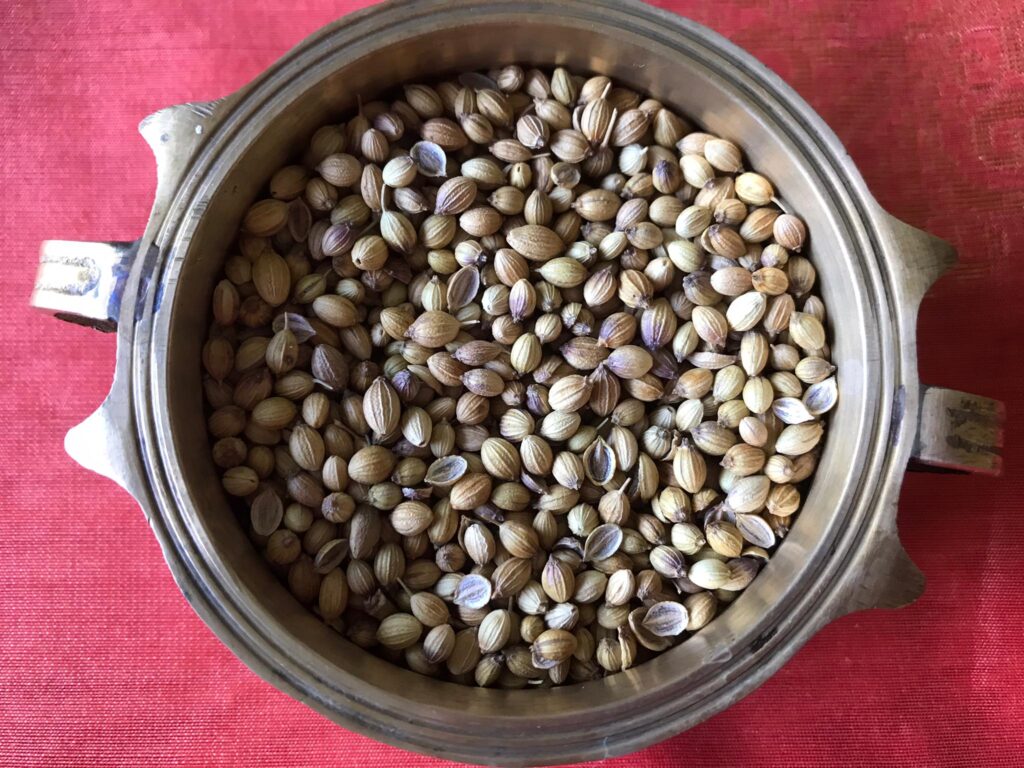
Coriander Leaves 
Coriander Seeds
A native of the Mediterranean region, although used chiefly as condiment or spice, it is equally well-known for its carminative and cooling properties.
Both the leaves of coriander and its seeds are used for cooking as well as in medicine. Coriander seeds are often dried and stored when ripe. The seeds cool down the entire body mechanism.
It is also a good household remedy for many Pitta disorders, particularly those of the digestive tract or urinary system. The fresh juice of leaves can be used either internally or externally for allergies, skin rashes , itch or inflammation. It increases digestion and absorption and is good for diarrhoea and dysentery.
Indian coriander is reported to contain a low amount of essential oils. This could be due to climatic factors.
Coriander: A Profile
Latin Name: Coriandrum Sativam L
Indian Name: Dhania, Kothmir
Family: Umbelliferae
Appearance: Aromatic Herb
Distribution: Widely cultivated, chiefly in Madhya Pradesh, Maharashtra, Mysore and Bihar
Coriander: How to use it
| Ailment | Prescription |
| Cataract | Powder 6 gm each of coriander seed and aniseed. Add 12 gm of unrefined sugar. Take half of this mixture in the morning and the remaining, the same evening. |
| Burning and swelling caused due to conjunctivitis | Decoction of dried coriander powder applied to affected area. |
| High cholesterol (Also acts as diuretic as kidneys are stimulated) | Boil 2 tsp dry coriander seed powder in one glass of water. (Milk and sugar can be added to improve its taste. This could be a welcome substitute for tea or coffee. |
| Headache | Mix equal quantities of sandal paste and coriander powder in a little water. Apply to affected area. |
| Headache | Apply extract of fresh coriander. |
| Diarrhoea | 2 or 3 tsp of coriander seeds soaked overnight in water are to be taken the next morning with buttermilk. |
| Indigestion, nausea, dysentery, hepatitis, typhoid fever | 1 to 2 tsp of fresh juice of coriander leaves, mixed in butter milk and taken 2-3 times. |
| Abdominal pain | Make a chutney with equal quantities of dry coriander seeds, ginger and grated coconut. Add a little salt to improve its taste. This is to be taken with boiled rice or plain chappati. |
| Diarrhoea | Boil 1 tsp cumin seeds (zeera) in a glass of water. Add to this 1 tsp fresh juice of coriander leaves and a pinch of salt. Drink twice daily after meals. |
| Excessive menstruation flow | Boil 6 gms coriander seeds in 50 ml of water till it is reduced to 250 ml. Add sugar and drink when lukewarm. Repeat twice or thrice a day. |
| Fatigue | Fry 1/2 tsp each of coriander seeds, cumin seeds, black pepper and tuvardal(harhar dal) in a little desi ghee. Make a tasty rasam by adding a little rasam powder, tomato and water. |
| Giddiness due to blood pressure | Soak some coriander seeds, sandalwood paste and dried amla (goose berries) in a glass of water. Strain and drink, the next morning. |
| Nervous weaknesses, osteoporosis, night-blindness , kidney problems, anaemia, indigestion | Frequent intake of coriander coffee as detailed in prescription 3 above. |
| Bleeding of the nose | Juice of fresh coriander leaves to be used as nasal drops. |
| Pimples, blackheads | Make a paste of 1 tsp juice of fresh coriander leaves and turmeric powder (haldi) . Apply daily as a face pack before going to bed. (Also avoid fatty foods, soap.) |
| Mouth ulcers | Make a decoction by boiling coriander seeds in water. Gargle frequently. |
| Vertigo | Soak 6 gm each of dried amla powder and coriander seeds in water overnight. Strain and drink next morning. Sugar may be added. Take for a few days. |
Caution
Dry coriander is not to be taken by persons suffering from bronchial asthma and chronic bronchitis. Some varieties of coriander may cause irritation to the skin when in contact for a long time.
